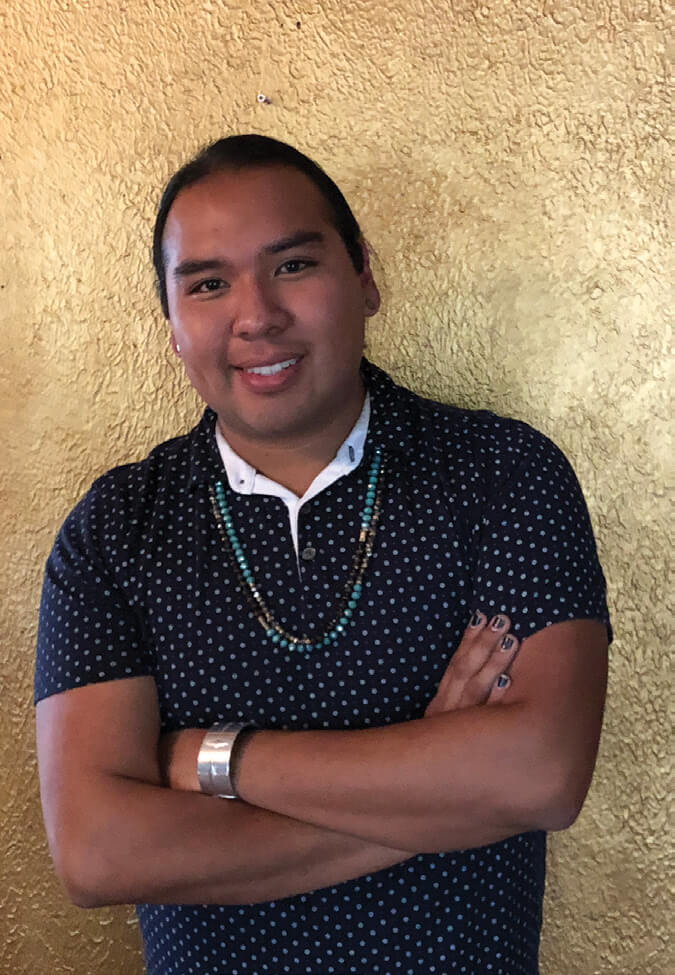
05 May Artist Spotlight: Hollis Chitto
Hollis Chitto’s beaded bag Bloodwork Number 2 might at first appear to be a beautiful piece of traditional American Indian art, its symmetrical design, bold colors, nature motifs, and painstaking handwork expressing centuries of heritage. However, a closer examination of the front panel reveals the imagery behind the title, detailed in ruby-colored beads flowing symmetrically downward, seemingly refracting and, in places, seeping into the design before breaking up into droplets.
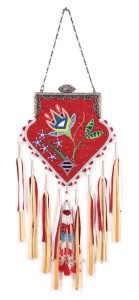
Red Delicious | Antique and Contemporary Seed Beads, Antique Purse Frame, Brain-Tanned Buckskin, Silk Ribbon, Swarovski and Chinese Crystal | 23 x 8.5 inches | 2022
The artist proudly explains that his inspiration began with an invitation in 2017 from the Abbe Museum, a respected ethnographic institution in Bar Harbor, Maine, to contribute to the fourth edition of its show Twisted Path, featuring artwork related to tribal identity. That installment’s health-focused theme, “Vital Signs,” led the Santa Fe, New Mexico-based artist — who’s Mississippi Choctaw on his father’s side and Isleta and Laguna pueblos on his mother’s — to explore issues related to HIV in the Native community.
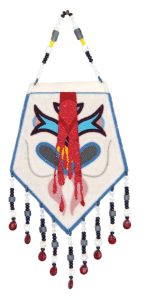
Bloodwork Number 2 | Antique and Contemporary Seed Beads, Swarovski Crystal, Chinese Crystal, Lapis, Czech Glass, Silk | Dupioni, Silk Habotai | 16 x 7 inches | 2017
“As I researched,” he says, “I learned about the high infection rate, due to not being able to talk about it because of the stigmas of HIV and drug use.” The fact that Chitto himself is proudly “Two-Spirit” — a pan-tribal term for queer — endowed the piece with even deeper meaning. The illusion that the blood in his design is transparent expresses that HIV “is not an end in itself, but just kind of changes the perspective.” As a final sign of hope, the bag’s obverse side simply shows a deep-blue sky dotted with cross-shaped morning stars symbolizing HIV positives — along with the artist’s beaded signature and his own negative symbol, sending out the message to “know your own status.”
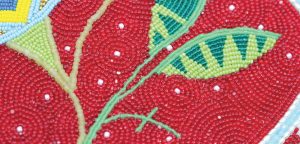
Chata Anumpa in My Accent | Antique and Contemporary Glass Seed Beads, Wool Fabric, Silk Dupioni Lining, Brass Bells, Silk | Tassels, Swarovski Crystal, Handmade Glass Beads, Brass Beads, Brass Sequins | 39 x 13 x 3 inches | 2020
Bloodwork stands as a remarkable achievement, and all the more so coming from an artist who turns only 33 this July. Yet Chitto has been steeped in art his entire life, growing up a son of sculptor Randy Chitto and his bride of 38 years Jackie Carpio, whom he met at Santa Fe’s Institute of American Indian Arts. At the age of 5, Hollis began showing and selling his own small fired and painted clay masks and shields in his father’s booth at Santa Fe’s annual Indian Market, even taking home the first-place ribbon one year. Before his teens, he switched mediums after finding “a stash of beads” at home. He taught himself ever-more-complicated classic techniques, making his first beaded bags during high school and soon devoting himself full-time to beadwork, inspired by innovative contemporary bead artists like Jamie Okuma; Ken Williams Jr.; Teri Greeves; Jackie Larson Bread; and the Growing Thunder family.
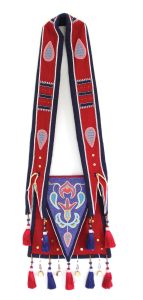
Chata Anumpa in My Accent | Antique and Contemporary Glass Seed Beads, Wool Fabric, Silk Dupioni Lining, Brass Bells, Silk | Tassels, Swarovski Crystal, Handmade Glass Beads, Brass Beads, Brass Sequins | 39 x 13 x 3 inches | 2020
Since his HIV-themed piece, Chitto has continued his innovative approach. Chata Anumpa in My Accent, for example, serves as a metaphor for studying his father’s language in adulthood, reinterpreting in modern vernacular a traditional Choctaw bandolier bag with such embellishments as Swarovski crystal beads and brass sequins and bells. And he’s begun beaded soft figural sculptures exploring gender expression, “reflecting how people dress now in the Native community.” In all these works, Chitto remains driven by the same inquisitive, creative force that first excited him about his medium. “I saw something new that I could learn, and I jumped at the chance.”
Find Hollis Chitto’s works at Hecho a Mano and Hecho Gallery, both in Santa Fe, New Mexico.






No Comments